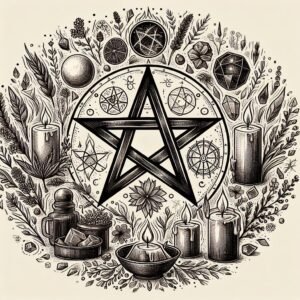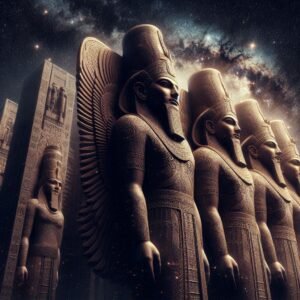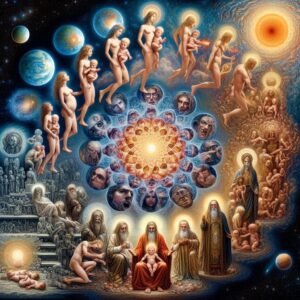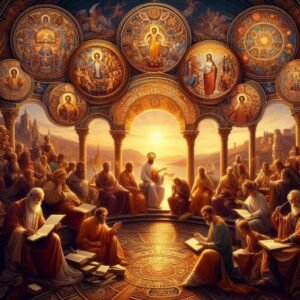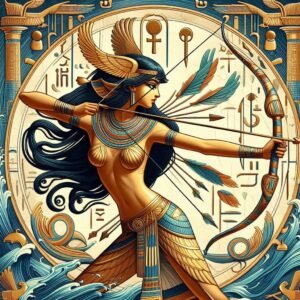
The primordial “goo” of creation
Many of the world mythologies include the concept that the world was created for some form of primordial goo, or water. For example, the “goo” in the Shinto creation myth refers to the primordial chaos from which the world was created. In the Shinto tradition, this chaos is described as a formless, swirling mass that existed before the heavens and the earth were separated. The deities Izanagi and Izanami used a jewelled spear to stir this chaos, and upon withdrawing it, the drops that fell from the spear’s tip formed the islands of Japan. This act of creation from chaos can be compared to other myths, such as the ancient Egyptian belief in the primordial waters of Nun, from which the benben, or the first mound of earth, arose. Similarly, in Greek mythology, the universe emerged from chaos, a vast void from which all things, including the gods, originated. Norse mythology also speaks of Ginnungagap, the great void from which the cosmos was shaped.
These myths share a thematic thread: the transition from a state of disorder to order, often represented by the separation of the earth from the heavens and the emergence of life. They also frequently involve a divine couple or entity that instigates this process, whether through direct action, like the stirring of the spear in Shinto myth, or through their own emergence, as Atum did from the waters of Nun in Egyptian lore. The act of creation itself is typically depicted as a sacred and ritualistic process, imbued with symbolism and meaning.
In examining these myths side by side, we observe a universal human curiosity about the origins of the world and our place within it. Despite the cultural and geographical distances between these civilizations, their creation myths exhibit remarkable similarities, suggesting a shared human experience and understanding of the world’s mysterious beginnings. These stories provide not only an explanation for the existence of the world but also a framework for the values and beliefs of the societies that hold them. They are, in essence, a reflection of humanity’s quest to make sense of the cosmos and our role in its ongoing story. Exploring these myths allows us to delve into the collective human psyche and uncover the archetypal themes that unite us across time and space.
Creation myths are a fundamental part of human culture, and many societies have their own narratives explaining the origins of the world and humanity. For instance, the Babylonian creation myth, known as the Enuma Elish, tells of the god Marduk who creates the world from the chaos left after a cosmic battle. In the Norse tradition, the world is formed from the body of the primordial giant Ymir, slain by the god Odin and his brothers. The Hindu Rig Veda speaks of the world beginning from a primordial being, Purusha, whose body parts become the various elements of the cosmos.
In the Americas, the Maya of Mesoamerica recount the creation of the world in the Popol Vuh, where the gods attempt to create humanity multiple times before succeeding. The Iroquois of North America believe in a world created on the back of a giant turtle. African cultures also have rich creation stories; for example, the Yoruba people speak of the god Olorun who sends the god Orishanla to create the earth, while the Zulu myth tells of the god Unkulunkulu who emerges from the reeds to create the world and everything in it.
These myths, while diverse in characters and events, often share common themes such as the emergence of order from chaos, the role of a supreme being or beings in creation, and the special place of humanity in the cosmos. They reflect the values, beliefs, and environment of the cultures that created them, providing insight into how different people understand their world and their place within it. By studying these myths, we can gain a deeper appreciation for the rich tapestry of human belief and the universal questions that have inspired these stories throughout history and across the globe.
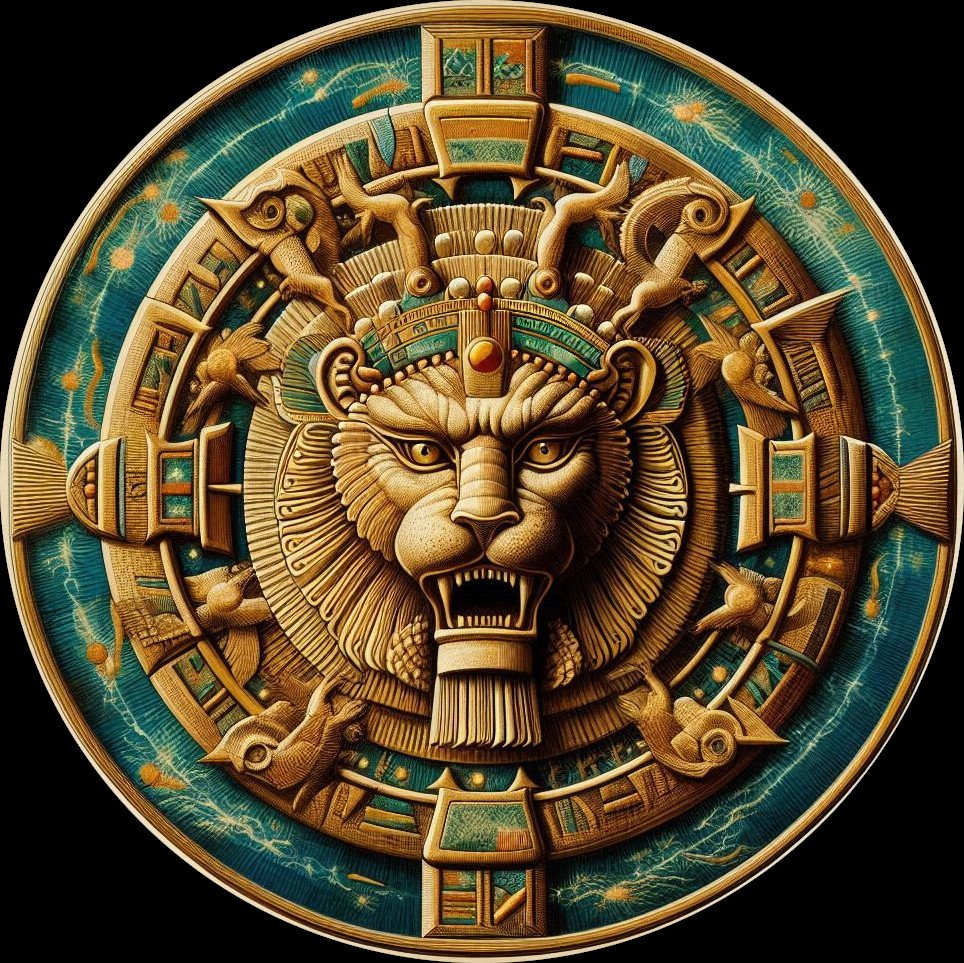
The Enuma Elish
The Enuma Elish, also known as The Seven Tablets of Creation, is an ancient Babylonian creation myth that is considered one of the oldest written narratives in the world. Its name originates from the opening lines “When on High,” and it details the story of the god Marduk’s rise to supremacy and his creation of the world from the defeated forces of chaos. The myth begins with the universe in a state of undifferentiated water, swirling in chaos, represented by the gods Apsu (fresh water) and Tiamat (salt water). Their mingling waters give birth to younger gods, who disturb Apsu with their noise, prompting him to plan their demise. However, the god Ea (also known as Enki), learns of Apsu’s plot and puts him to sleep, subsequently killing him. From Apsu’s remains, Ea creates his home.
Tiamat, enraged by the death of Apsu and spurred on by the god Quingu, decides to wage war against the younger gods. In response, the younger gods elect Marduk as their champion. Marduk is granted special powers and weapons to defeat Tiamat. In a dramatic battle, Marduk defeats Tiamat, and from her body, he creates the heavens and the earth. The Enuma Elish continues with Marduk’s organization of the cosmos, the creation of human beings, and the assignment of tasks to the gods, establishing a divine order.
The Enuma Elish played a significant role in Babylonian society, particularly during the Akitu festival, which celebrated the Babylonian New Year and the re-enactment of creation. The recitation of the Enuma Elish during this festival symbolized the renewal of life and order, coinciding with the seasonal flooding of the Tigris and Euphrates rivers that brought fertility to the land. The myth not only served as a religious text but also as a political tool, reinforcing the supremacy of Babylon and its chief deity, Marduk, over other cities and their gods. It reflects the world-view of the ancient Babylonians, where the cosmos is brought into order from chaos, and humanity is created to serve the gods.
In the epic Babylonian myth of the Enuma Elish, Marduk’s victory over Tiamat is a dramatic and symbolic tale of order triumphing over chaos. Marduk, a younger god representing order, faced Tiamat, the goddess of salt waters and chaos. The battle between Marduk and Tiamat was not only a physical confrontation but also a cosmic struggle to establish order in the universe.
According to the myth, Marduk was armed with powerful weapons and magical items bestowed upon him by the other gods, who promised him supremacy if he could defeat Tiamat. Among his arsenal were a bow, a mace, and the four winds, which he used to his advantage during the battle. Marduk also carried a net, a gift from the god Anu, which played a crucial role in the encounter.
The battle commenced with Marduk using his net to ensnare Tiamat, preventing her from escaping. He then unleashed the mighty winds, which, directed into her mouth, inflated Tiamat’s body, rendering her vulnerable. With her body distended, Marduk fired an arrow that pierced her heart, effectively ending her life and her reign of chaos. This decisive moment is vividly depicted in the myth, symbolizing the establishment of a new order.
After defeating Tiamat, Marduk did not stop there; he split her body into two halves, from which he created the heavens and the earth, thus shaping the world as known to the ancient Mesopotamians. This act of creation from the corpse of a vanquished chaotic entity is a powerful image that resonates with the theme of life emerging from destruction and order from disorder.
Marduk’s triumph over Tiamat is celebrated as the moment when a new era of order was ushered in, with Marduk assuming his role as the King of the Gods. His victory is commemorated in the Enuma Elish, which was recited during the Babylonian New Year festival, symbolizing the renewal of life and the reaffirmation of order.
The myth of Marduk and Tiamat is a profound narrative that has captured the imagination for millennia, reflecting the human desire for order and stability in a world that can often seem chaotic and unpredictable. It is a testament to the enduring power of myth to convey deep truths about the human condition and the cosmos.
The death of Tiamat in the Enuma Elish can be reinterpreted in various ways, including the perspective that she imparted an aspect of herself to Marduk. This interpretation aligns with a common theme in mythology where the defeated entity contributes something essential to the victor or to the new order established post-conflict. In the case of Tiamat and Marduk, Tiamat’s demise led to the creation of the world, suggesting that her body and by extension, her essence, became the very fabric of the cosmos that Marduk organized.
Such a reinterpretation could suggest a more complex relationship between chaos and order, where chaos is not merely a force to be vanquished but also a necessary component in the creation of the world. It implies that Marduk’s victory and subsequent creation were not possible without Tiamat’s contribution, thus acknowledging her role in the cosmogony. This view can be seen as a symbolic representation of the interdependence of opposing forces and the idea that creation often involves transformation and sacrifice.
In broader terms, this interpretation could reflect the ancient Mesopotamian view of the cosmos as a place where life and order are born out of conflict and destruction. It also resonates with the concept of cyclical time and the notion that endings are beginnings in disguise. By viewing Tiamat’s death as a form of giving, it adds a layer of depth to the myth, suggesting a cycle of renewal where each end is a precursor to a new creation.
This perspective also opens up a dialogue about the nature of power and the legacy of the defeated. It posits that Tiamat’s influence continued beyond her physical existence, living on through the ordered world Marduk created. It’s a narrative that finds echoes in other myths and stories where the fallen, through their defeat, contribute to the greater narrative of the world’s ongoing creation and evolution.
In literary and psychological analysis, such reinterpretations are valuable for understanding the multifaceted nature of myths and the characters within them. They allow for a richer exploration of the themes and symbols inherent in these ancient stories, providing insights into the human condition and the perennial questions about the origins and structure of the universe. The Enuma Elish, with its vivid imagery and profound themes, continues to be a source of inspiration and contemplation, demonstrating the enduring power of myth to capture the imagination and provoke thought.
The personification of the primordial goo
In Mesopotamian mythology, deities often emerge from and return to primordial sources, this suggests the concept of a singular entity that both Marduk and Tiamat could have split from is not far-fetched. Such an entity would likely embody the very essence of creation and existence, transcending the dichotomy of order and chaos represented by Marduk and Tiamat.
One candidate for this primordial source could be the god Anu, the supreme deity who embodies the sky and is often considered the highest of the gods. Anu represents the infinite expanse above, a domain of the gods that is both the source of life-giving rains and the abode of celestial bodies. In some interpretations, Anu, along with Ki, the earth goddess, forms a primordial pair from which the pantheon of Mesopotamian deities descends.
Another possibility is Nammu, the Sumerian creation goddess associated with the primeval sea. Nammu is often credited with giving birth to the first generation of gods and is thus a fitting representation of the origin of all things. As the personification of the primal waters, Nammu could be seen as the source from which both the forces of order (Marduk) and chaos (Tiamat) arise.
The concept of a singular origin is also echoed in the figure of Abzu (or Apsu), the god of fresh water, who, along with Tiamat, represents the primordial chaos before the cosmos was ordered. Abzu’s waters are the birthplace of the first gods, and his existence predates the ordered universe, making him a potential candidate for the unified entity from which Marduk and Tiamat could have originated.
The idea of a single source splitting into entities representing order and chaos is a powerful symbol of the dynamic balance that underlies existence. It suggests that creation is not a moment but a process, one that involves the interplay of contrasting yet complementary forces.
In Greek mythology, Chaos is the void state preceding the creation of the universe, and from it emerged the first deities, including Gaia (Earth), Tartarus (the Abyss), and Eros (Love). Chaos as a deity personifies the initial gap created from nothingness, the yawning chasm from which all existence sprang.
The Norse myths speak of Ymir, the primordial giant whose body was used by Odin and his brothers to create the world. Ymir embodies the raw material of creation, much like Tiamat, and his demise at the hands of the gods led to the formation of the earth, skies, and seas.
In Hindu mythology, there is the cosmic serpent, Vritra, who embodies drought and obstruction and is slain by Indra, the god of thunder, to release the waters and bring order to the world. This act of slaying a primordial entity to initiate creation mirrors the narrative of Marduk and Tiamat.
The Egyptian pantheon includes Nu, the personification of the primordial waters, from which all creation began. Nu represents the chaotic waters that existed before the emergence of the first land. Similarly, Apep, the great serpent, embodies chaos and is the eternal opponent of Ma’at, the concept of order and balance.
In Canaanite mythology, Yam is the god of the sea and represents chaos and disorder, often paralleled with Tiamat from the Mesopotamian myths. His narrative involves conflict with other deities, reflecting the chaotic nature of the sea and its association with primordial beginnings.
The concept of a primordial chaos deity is not limited to these examples. Many cultures around the world have conceived of similar figures, each contributing to the rich mosaic of creation myths that seek to explain the origins of the cosmos and the human condition. These deities, though varied in name and narrative, share a common role as the embodiment of the raw, untamed forces of nature that predate and participate in the creation of order in the universe.
The exploration of these deities offers a glimpse into the human psyche’s attempt to grapple with the unknown and to personify the forces that are beyond human control. They represent the beginning of everything, the first cause from which the ordered world emerged. As such, they hold a special place in the mythological canon, serving as symbols of the infinite potential and the mysterious origins of existence. Through their stories, we can trace the threads of human thought across cultures and epochs, finding a shared understanding of the world’s beginnings that transcends the boundaries of time and place. These primordial deities invite us to reflect on the nature of creation itself, the cycle of order and chaos, and the enduring human quest to comprehend the cosmos’ vast and timeless mysteries.

The Goddess Nammu
Nammu is a primordial goddess in Sumerian mythology, often associated with the creation of the world and humanity. She represents the primeval waters, an embodiment of the sea or ocean from which life emerges, akin to the concept of chaos in other mythologies. Nammu is considered the mother of the god Enki, also known as Ea, who is associated with wisdom, water, and creation. In some accounts, she is also referred to as the mother of An (Heaven) and Ki (Earth), further cementing her role as a creator deity.
Her significance in the pantheon is highlighted by her connection to incantations and apotropaic magic, indicating her role in the protection and purification rituals within the Sumerian culture. Despite her fundamental role in the creation myths, Nammu was not a widely worshipped deity in ancient Mesopotamia. However, she did have a temple dedicated to her in the city of Ur, and her name appears in texts from Nippur and Babylon, suggesting a level of reverence and importance.
Nammu’s narrative is unique in that it does not involve the violent conflicts typical of other creation stories, such as the battle between Marduk and Tiamat in the Babylonian Enuma Elish. Instead, her role is more maternal and nurturing, as she gives birth to the gods and, by extension, the cosmos itself. This portrayal of Nammu aligns with the Sumerian view of the universe as a place of harmony and order that arises naturally from the primeval chaos, rather than through violent upheaval.
The mythology surrounding Nammu provides insight into the Sumerian understanding of the world’s origins. It reflects a world-view where the earth and heavens are born from a harmonious union rather than conflict, and where the sea, a source of life, is revered as a divine and creative force. Nammu’s presence in these myths underscores the importance of water in Sumerian culture, both as a life-giving resource and as a symbol of the mysterious forces of creation.
In exploring Nammu, we delve into the collective memory of an ancient people and their attempts to explain the world around them. Through her story, we can appreciate the Sumerians’ reverence for the natural world and their belief in a cosmos that is inherently ordered and good. Nammu’s legacy, though not as prominent as some other deities in Mesopotamian history, remains an essential part of the tapestry of human mythology, representing the eternal and universal quest to understand our origins and our place in the universe.
Nammu of the primeval waters
She is the personification of the primeval waters, the Apsu, representing the chaotic and fertile abyss that predated the cosmos. According to the myth, Nammu, in her role as the original creator, brought forth An (the sky) and Ki (the earth), thereby establishing the framework of the universe. Her union with herself, or perhaps with the fresh waters, produced Enki (also known as Ea), the god of wisdom, water, and creation, who would go on to play a pivotal role in the organization of the world and the formation of humanity.
The narrative of Nammu’s birthing of the gods does not involve violence or conflict, unlike other creation myths where the world is formed from the body of a slain deity. Instead, it emphasizes a harmonious emergence of life from the waters, reflecting the Sumerian reverence for the life-giving properties of water and the sea. Nammu’s creative act is seen as a natural and spontaneous generation, a divine conception that brought order to the universe.
In the myth “Enki and Ninmah,” Nammu is also involved in the creation of mankind alongside Enki and a group of minor goddesses. She advises Enki to use clay from the top of the Apsu, the primeval waters, and the blood of a slain god to create the first humans. This act further cements her role as a mother figure, not only to the gods but also to humanity. It is a testament to her nurturing and life-giving nature, as she provides the essential materials for the creation of life.
Nammu’s contribution to the Sumerian pantheon is profound. She sets in motion the events that lead to the rich tapestry of gods and goddesses that populate Sumerian mythology. Her actions are foundational, making her one of the most significant deities in the Sumerian belief system. The creation of the gods by Nammu is a symbolic representation of the emergence of order from chaos, a theme that resonates throughout various creation myths around the world.
The story of Nammu is not just a tale of the birth of deities; it is also a reflection of the Sumerian understanding of the cosmos. It portrays a universe that is born from a harmonious and maternal source, a stark contrast to the tumultuous and often violent narratives found in other ancient mythologies. Nammu’s peaceful creation of the gods suggests a world-view where harmony and balance are inherent in the fabric of existence.
Nammu in ancient literature
Her presence is felt in various ancient texts, where she is revered as the mother of the gods and the creator of the cosmos. One of the most significant references to Nammu can be found in the myth “Enki and Ninmah,” where she advises her son Enki to use clay from the top of the Apsu, the primeval waters, to create mankind. This narrative not only highlights her role as a creator but also emphasizes her maternal nature and her intrinsic connection to the element of water, which was central to Sumerian culture.
In addition to this myth, Nammu is mentioned in various incantations and magical texts, underscoring her role in protection and purification rituals within Sumerian society. Her name appears in texts from Nippur and Babylon, indicating her widespread recognition and importance across ancient Mesopotamia. The worship and rituals dedicated to Nammu, particularly in the city of Eridu, reflect her influence and the high regard in which she was held. Her temple in Ur serves as a testament to her significance in the Sumerian pantheon.
The Electronic Text Corpus of Sumerian Literature, maintained by the University of Oxford, is a valuable resource for exploring Sumerian texts that feature Nammu. This extensive collection includes transliterations and translations of Sumerian literature, offering insights into the religious and cultural practices of the time. Through these texts, scholars and enthusiasts alike can delve into the world of ancient Mesopotamia and gain a more profound understanding of Nammu’s role and legacy.
Nammu as a triple goddess
The concept of the Triple Goddess, a form that embodies the threefold aspects of the divine feminine—maiden, mother, and crone—is a recurring motif in various mythologies and spiritual traditions. Nammu’s association with the creation of the cosmos and life itself lends her a natural alignment with the mother aspect of the Triple Goddess archetype. As the mother of Enki, the god of wisdom, water, and creation, Nammu’s influence extends beyond the mere act of creation; she is the progenitor of wisdom and the guiding force behind the ordered universe.
The embodiment of Nammu as the original Triple Goddess suggests a deeper, more profound understanding of the divine feminine’s role in creation myths. She is not only the source from which life flows but also the guiding force that shapes the destiny of gods and mortals alike. Her presence in the myth “Enki and Ninmah” as a creator alongside her son Enki and a group of minor goddesses emphasizes her central role in shaping humanity and the world. This narrative sets her apart from other creation myths, such as the Atra-Hasis, which do not mention her directly, highlighting her unique position in Sumerian mythology.
Nammu’s portrayal as the mother of all triple goddesses suggests that she is the primordial source from which various expressions of the divine feminine emerge. Her role in the creation of An (Heaven) and Ki (Earth) further cements her status as the cosmic matrix from which the fabric of reality is woven.
In exploring Nammu as the embodiment of the original Triple Goddess, one can draw parallels with other mythological figures such as the Greek Hecate, the Celtic Mórrígan, or the Hindu Tridevi. Each of these figures represents the triple aspects of the goddess in their respective cultures, reflecting a universal pattern of the divine feminine’s role in creation, preservation, and transformation. Nammu’s association with water, a symbol of life, fertility, and purification, aligns her with the life-giving and nurturing aspect of the Triple Goddess, while her involvement in incantations and apotropaic magic connects her to the transformative and protective qualities of the crone aspect.
Nammu, as the original Triple Goddess, represents the full spectrum of the divine feminine’s power and wisdom. Through the lens of Nammu, we can glimpse the eternal dance of creation, preservation, and transformation that underpins the cosmos and the human spirit.
Nammu, as a representation of the primeval sea and the origin of life in Sumerian mythology, shares common ground with the Triple Goddess archetype found in various cultures, which often symbolizes the lifecycle of a woman through the phases of Maiden, Mother, and Crone. This archetype reflects the different stages of life and the inherent wisdom within each phase, resonating with the moon’s waxing, full, and waning states. Nammu’s role as the creator aligns her with the Mother aspect, nurturing and overseeing the birth of the cosmos and humanity.
In Greek mythology, Hecate is a prominent figure associated with the Triple Goddess concept. Initially linked to wilderness and childbirth, Hecate evolved to become a deity of magic, witchcraft, and the night, capable of traversing the realms of the living and the dead. Her depiction often includes three forms or faces, symbolizing her dominion over the earth, sea, and sky, and her ability to see past, present, and future.
The Roman counterpart to Artemis, Diana, is another example of a triune goddess, embodying the huntress, the moon, and the underworld. This multifaceted nature highlights her roles across different realms and her connection to the cycles of life and death. Similarly, the Celtic tradition boasts figures like Brigid, Rhiannon, and Cerridwen, each embodying different aspects of the divine feminine and the Triple Goddess motif.
In Norse mythology, the Norns, akin to the Greek Fates, are depicted as three women representing youth, maturity, and old age, governing the fate of the world. These figures, along with others like the Celtic Morrigan or the Hindu Tridevi, showcase the Triple Goddess’s universality, embodying creation, preservation, and transformation across different cultures and spiritual beliefs.
Comparatively, Nammu’s portrayal lacks the explicit triadic nature seen in these other cultures. However, her encompassing role as the source of life and wisdom can be interpreted as an embodiment of all three aspects of the Triple Goddess. Her narratives emphasize the seamless transition from chaos to order, mirroring the lifecycle stages represented by the Triple Goddess. Nammu’s maternal nature and her involvement in the creation of both gods and humans resonate with the nurturing and life-giving attributes of the Mother aspect.
Celebrating Nammu
In Sumerian religious life, festivals and rituals played a pivotal role in maintaining the cosmic order and expressing reverence for the pantheon of deities that governed every aspect of existence. Nammu, the primordial sea goddess, though central to the creation mythos of the Sumerians, does not feature prominently in the records of specific rituals or festivals as some other gods do. This could be attributed to the more foundational and less interventionist nature of her role within the pantheon. However, it is likely that rituals and ceremonies dedicated to Nammu would have been imbued with symbolism reflective of her domain over the primeval waters and her role as the progenitor of the gods.
The Akitu festival, one of the oldest recorded New Year celebrations, was a significant event in Sumerian and later Mesopotamian culture, though it was primarily associated with the chief deity of a city-state, such as Marduk in Babylon. While Nammu was not the central figure of this festival, the creation themes celebrated during Akitu resonate with her mythological functions. It is conceivable that during such festivals, there were elements of homage paid to Nammu as the mother of creation, given the Sumerians’ deep-seated belief in the interconnectedness of divine forces.
Festivals in ancient Mesopotamia often included processions, music, dance, and performances, which could have highlighted Nammu’s role in the creation of the world. These communal celebrations served not only as acts of worship but also as means to establish a profound connection with the divine, seeking favourable intervention in various aspects of life. Temples and shrines dedicated to Nammu likely saw rituals that involved the pouring of water as offerings, symbolizing her connection to the sea and the life-giving properties of water. Such rituals would have been a symbolic representation of Nammu’s generative powers, invoking her essence for fertility, abundance, and purification.
The scarcity of detailed records on specific rituals for Nammu may also reflect her overarching and somewhat abstract nature. As the embodiment of the primeval waters, Nammu represented a cosmic principle rather than an anthropomorphic deity who interacted regularly with humanity. Thus, the rituals associated with her would have been deeply symbolic, perhaps more concerned with the cyclical nature of creation and renewal than with the more human-like narratives and interventions of other gods.
In summary, while the historical record may not provide explicit details of rituals or festivals exclusively dedicated to Nammu, understanding her central role in Sumerian cosmology allows us to infer the types of ceremonies that would have been appropriate for her worship. These would have been ceremonies steeped in the symbolism of creation and the life-sustaining powers of water, reflecting the Sumerians’ reverence for the forces that shaped their world and their lives. Through these rituals, the ancient Sumerians would have expressed their gratitude and sought to ensure the continued favour of the goddess who set the stage for the existence of the universe and all within it. The legacy of Nammu, though not as vividly depicted in festivals as other deities, remains an integral part of the spiritual fabric of ancient Mesopotamian society. Her influence, like the waters she personified, underlies the myriad expressions of faith and worship that flowed through the heart of Sumerian culture.
Symbolism of Nammu
Nammu, the Sumerian goddess of the primeval sea, is often associated with symbols and motifs that reflect her domain over the waters and her role as a creator deity. The symbols attributed to Nammu include the water symbol, representing her connection to the primordial waters from which all life emerged. This symbol is deeply significant as it encapsulates the essence of creation and the life-sustaining properties of water, which was a central element in Sumerian culture and mythology. Additionally, the serpent symbol is associated with Nammu, signifying wisdom, fertility, and transformation. The serpent, often a symbol of rebirth and renewal due to its ability to shed its skin, aligns with Nammu’s role in the cyclical nature of creation and the continuous flow of life. The fish symbol is another emblem linked to Nammu, representing abundance, fertility, and the life-giving powers of water. Fish, which were abundant in the rivers of Mesopotamia, were essential to the Sumerian way of life, both as a food source and as a symbol of the gods’ providence.
These symbols are not merely decorative; they carry profound meanings and are reflective of the Sumerian understanding of the cosmos and their place within it. The water symbol, for instance, is a reminder of the primordial abyss, the Apsu, from which the Sumerian world was believed to have been created. It is a representation of potentiality and the source of all existence. The serpent, with its connotations of wisdom, may also be seen as a nod to Nammu’s son, Enki, the god of wisdom, further linking her to the intellectual and creative forces within the pantheon. The fish, a symbol of sustenance, underscores the nurturing aspect of Nammu as the mother who provides for her creations.
While specific sacred animals are not directly mentioned in the available records as being associated with Nammu, the use of animal symbolism to represent deities was common in Sumerian and broader Mesopotamian cultures. Animals were often seen as manifestations of divine power and were sometimes used in rituals and iconography to invoke the presence of a particular god or goddess. Given Nammu’s association with the life-giving waters, it is conceivable that aquatic creatures, particularly those that inhabit the rivers and seas, would have held a special place in any worship practices related to her.
In summary, the symbols associated with Nammu—water, serpent, and fish—each reflect different facets of her divine persona and functions. They serve as a bridge between the human and divine realms, providing the Sumerians with a means to understand and interact with the forces that shaped their world. Through these symbols, Nammu’s presence was invoked and honoured, ensuring her continued relevance and reverence in the spiritual life of ancient Mesopotamia.
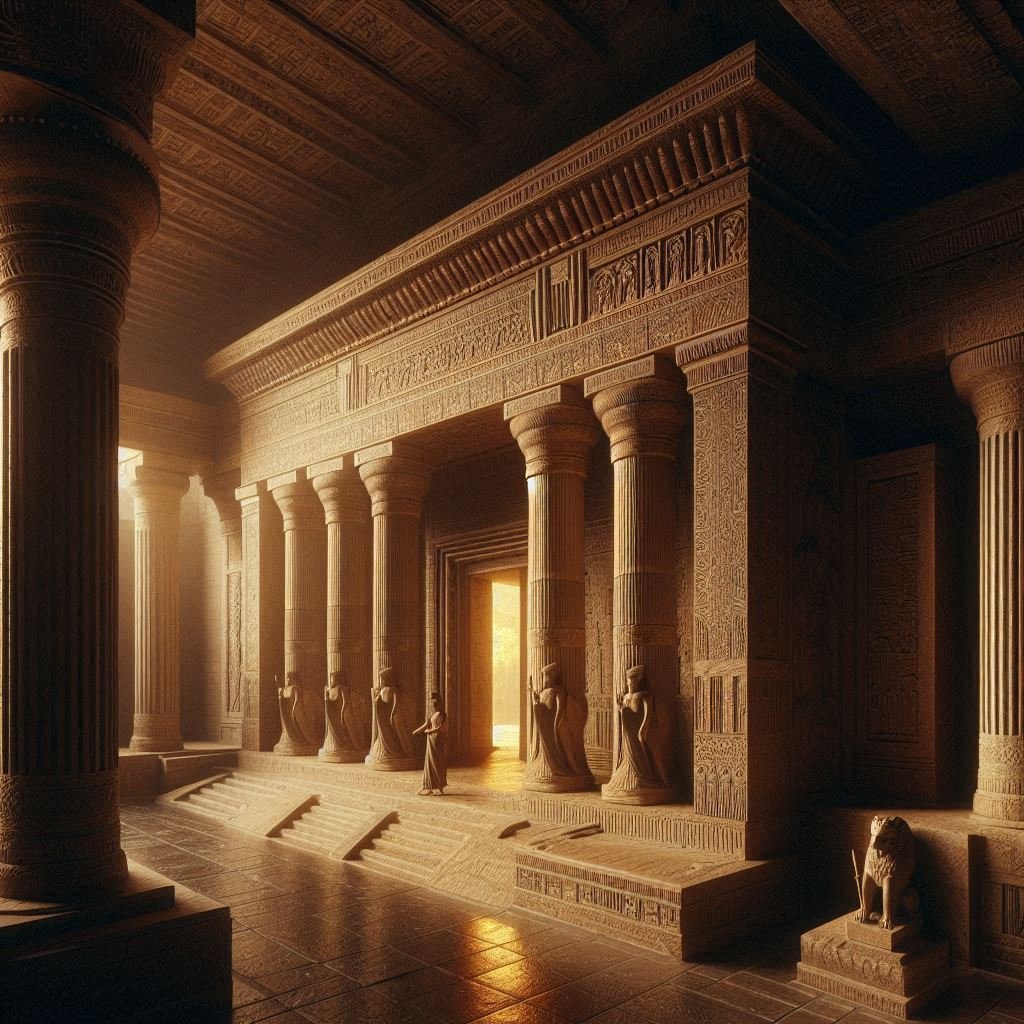
Centres of Nammu worship
Nammu was revered in the ancient city of Eridu, which is considered one of the earliest urban settlements in the Mesopotamian region. In Eridu, Nammu was acknowledged as a creator deity within the local theology, and her worship was integral to the city’s religious practices. A temple dedicated to Nammu existed in Ur, particularly during the Old Babylonian period, serving as a major cult centre where she was honoured and venerated. This temple would have been a focal point for rituals and ceremonies, reflecting her importance in the pantheon as the mother of Enki, the god of wisdom, water, and creation. The presence of such a temple indicates that Nammu held a significant place in the hearts and minds of the people of Ur, who would have looked to her as a source of life and a guiding force in the cosmos.
In addition to the temple in Ur, Nammu is also attested in texts from Nippur and Babylon, suggesting that her influence extended beyond Eridu and that she was recognized across various regions of Mesopotamia. While the details of the rituals and the exact nature of the worship conducted at these temples are not fully known, it is likely that they involved offerings and prayers that aligned with her role as the primeval source of creation. The water poured as offerings in these temples would have symbolized her connection to the sea and the life-giving properties of water, which was a central element in Sumerian culture and mythology.
The reverence for Nammu in these cities, particularly through the establishment of temples and shrines, underscores the significance of the divine feminine and its role in creation. Her portrayal as a nurturing and creative force would have been a source of inspiration for the Sumerians, who saw the natural world as imbued with the divine. The temple in Ur, along with references to her in other important cities, reflects the widespread recognition of Nammu’s role in the Sumerian belief system and the high regard in which she was held.
Subscribe to our post updates - Don't miss a thing!!

